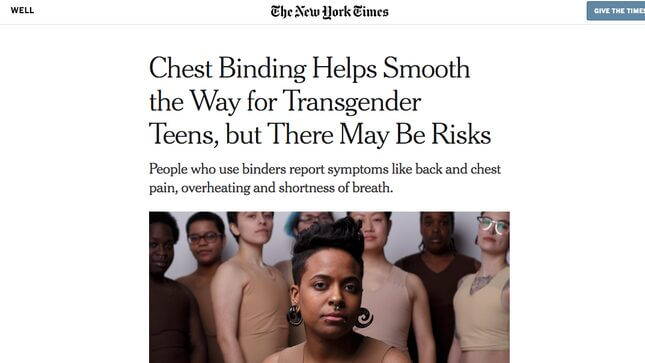At the New York Times, 'Objectivity' Means Quoting One Trans Teen and One Anti-Trans Group
Latest

“It used to be that when a 13-year-old wanted a binder for school, it meant a trip to Staples. For today’s tweens and teens who identify as gender-nonconforming or transgender, shopping for a binder may mean a compression undergarment worn to flatten breasts.” So begins a new, irresponsible piece in the New York Times, which from its very first words sets up the practice of binding as an alarming trend—the opposite of wholesome school prep.
Chest binding is, in fact, an old practice, popular especially among trans and gender non-conforming teens seeking to flattening their chests to reduce the appearance of breasts, at a low cost. Despite its ubiquity, research on the effects of chest-binding is minimal, and reporting on it sparse—making it a subject particularly worthy of coverage. But the Times’ piece on chest-binding takes a terrible approach, overblowing the risks of the practice—some of which are based in fact, others based in dangerous fear-mongering-fictions—while not just minimizing, but omitting entirely the perspective of the people who rely on and benefit from the practice the most.
The Times focuses on a single piece of research, a groundbreaking 2017 study by Boston University public health and medical students on the health impacts of chest-binding in the trans community. The study, the first-ever to look at the health impacts of chest-binding among trans youth and young adults, found that, while 97 percent of respondents reported experiencing at least one negative physical symptoms—back pain, chest pain, or shortness of breath, among others—most surveyed reported that the benefits outweighed any physical side effects.
“Based on our preliminary analysis, for most participants, binding was a positive experience and led to improvements in mood and self-esteem, minimized gender dysphoria, anxiety, and depression, and helped them to feel in control of their bodies,” the study’s authors wrote, according to a Vice article. “In fact, some reported that a positive impact on emotional and behavioral health makes the physical discomfort of binding worth it.”
The Times reported on the study’s findings, but rather than interrogating the benefits outlined, it focused almost exclusively on the medical risks. The Times interviewed only one trans person undertaking the practice—quoting the teen about his pain, but not the reasons he bound his chest, or how doing so affected his mental health.
The Times interviewed only one trans person undertaking the practice—quoting the teen about his pain, but not the reasons he bound his chest.
Nor does the Times explore the obstacles trans youth face within the medical system—a prime reason binding, which is easily accessible, is popular. It would have been relevant to include a 2018 study, in which researchers found that transgender people face significant discrimination from healthcare providers when seeking care, which in turn prevents them for reporting symptoms. Or a few statistics, like that one-third of trans people in the U.S. report having been harassed or refused treatment while seeking care.
Instead, the Times extensively quoted anti-trans group 4thWaveNow—a group that, according to its website, was created out of a single mother’s “deepening skepticism of the ever-accelerating medical and media fascination with the phenomenon of ‘transgender children.’” The Times quotes this description from the website instead: “a community of parents and others concerned about the medicalization of gender atypical youth.”
“Binding is not benign,” 4thWaveNow spokesperson Brie Jontry told the Times. “It encourages the idea that people’s distress and anger and trauma should be turned inward toward their own bodies instead of outward toward the culture that feels oppressive to them.” Jontry’s opinion is a common, and unfounded, talking-point among anti-trans groups—the idea that body alteration is a psychologically unhealthy practice, spurred by unrelated trauma.
Yet the article relies heavily on Jontry’s testimony and the thoughts of doctors who are concerned with the practice, offering only a single brief quote from a trans teenager who practices binding, on the negative physical side effects of the practice. No trans people were quoted about what the binding is like in practice, the reasons that prompted them to participate in it, and the emotional or psychological effects of binding.
“Binding, for many transgender and gender nonconforming people, is life-saving and brings their bodies into better alignment with who they are,” Alex Schmider, Associate Director of Transgender Representation at GLAAD, told Jezebel in a statement. “This NYT story and the social media pushback it has received underscores the need for journalists who cover underrepresented communities to seek out members of that community to listen to, learn from, and understand their lived experience.”
It’s not that such testimony would be hard for the Times to find: It could have cited this observation by Megan Jones, who wrote this about chest-binding in Flare Magazine: “I haven’t completely made peace with my chest—but on the days I need it, the practise has allow me to feel more confident and at home in my body.” Or this account from Naomhan, a non-binary trans activist from Belfast, Northern Ireland, who told Vice: “An ex-boyfriend gave me his old binder and after I put it on, I remember looking down at my chest and then into the mirror, feeling euphoria at how happy it made me feel.”
But that would’ve required the Times to actually examine the experience of trans people by (gasp) talking to them—a thing that many prominent outlets, including the Atlantic, seem to think is optional part of reporting. The Times’ reliance on non-trans doctors, researchers, parents, and even specifically anti-trans advocacy groups, says more about who the Times is comfortable speaking with rather than anything about binding. The result is fear-mongering article that further damages a group that faces alarming rates of suicide and violence, another essential factoid left out of the piece. This piece, and others like it, masquerade as insight to cis people, but in fact are a vehicle for anti-trans myths and fears.